

Dentistry - Open CourseWare. Test Equating For Comparable Passing Standards. The purpose of test equating is to place examination administrations on the same Benchmark Scale.

The differences in the difficulty of the two administrations are accounted for so the same criterion-referenced standard can be used from administration to administration. For certification testing, Rasch common item test equating is frequently used in conjunction with a criterion-referenced standard. First a criterion-referenced standard is established on a Benchmark Scale. The data from an exam is used to calibrate the Benchmark scale. The exam should match the test blueprint to assure content validity, and it should include a sufficient number of items that have been field-tested or previously used, to insure that the exam is a satisfactory measure of the construct.
Equating to that Benchmark Scale and criterion standard requires that subsequent test administrations include a number of items that are calibrated to the Benchmark Scale (commonly called equators). Test Taking Skills. Nursing instructors give multiple-choice tests to prepare students for the N-CLEX RN.
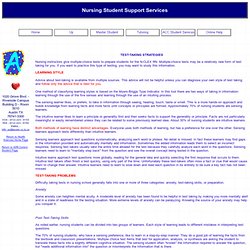
Multiple-choice tests may be a relatively new form of test taking for you. If you want to practice this type of testing, you may want to study this information. Advice about test-taking is available from multiple sources. This advice will not be helpful unless you can diagnose your own style of test taking and follow only the advice that is best for you. One method of classifying learning styles is based on the Myers-Briggs Type Indicator. The sensing learner likes, or prefers, to take in information through seeing, hearing, touch, taste or smell.
The intuitive learner likes to learn a principle or generality first and then seeks facts to support the generality or principle. Both methods of learning have distinct advantages. Sensing learners approach test questions systematically, analyzing each word or phrase. Anxiety Some anxiety can heighten mental acuity. Poor Test-Taking Skills Preparation Eat well. Test Taking Strategies. Examinations are a fact of life in college.

But the only time an exam should be a trial is when you aren't prepared for it, and the best sign that you aren't prepared is when you have to stay up all night to "cram. " Cramming won't do very much for you (except make you so tired that when you take the exam you won't be able to think clearly enough to answer the questions you DO know). Here are some tips to help you develop test taking skills: National Dental Examining Board of Canada. PEDIATRIC ENDODONTICS PULPECTOMY. Reading Skills. When you're a graduate people expect you to use a vocabulary which is wider than a school-leaver's.

To expand your vocabulary: Choose a large dictionary rather than one which is ‘compact' or ‘concise'. You want one which is big enough to define words clearly and helpfully (around 1,500 pages is a good size). Avoid dictionaries which send you round in circles by just giving synonyms. A pocket dictionary might suggest: ‘impetuous = rash'. Active Reading Strategies - McGraw Center - Princeton University. Learning Support - Counselling and Development - Concordia University - Montreal, Quebec, Canada. BCCC OL Wrap Up Quiz. Netiquette quiz. Normal and abnormal dental development. Abstract Teeth are vertebrate organs that arise from complex and progressive interactions between an ectoderm, the oral epithelium and an underlying mesenchyme.
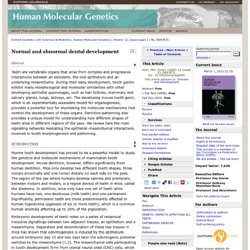
During their early development, tooth germs exhibit many morphological and molecular similarities with other developing epithelial appendages, such as hair follicles, mammary and salivary glands, lungs, kidneys, etc. The developing mouse tooth germ, which is an experimentally accessible model for organogenesis, provides a powerful tool for elucidating the molecular mechanisms that control the development of these organs. Dentition patterning also provides a unique model for understanding how different shapes of teeth arise in different regions of the jaws. We review here the main signalling networks mediating the epithelial–mesenchymal interactions involved in tooth morphogenesis and patterning. Whatever the final shape of the tooth, early steps of tooth development in mammals are very similar. Figure 1. Gli transcription factors.
Basic Growth and Development of the Face and Dental Arches Development & Morphology of Teeth. Knowledge of normal development will aid in the understanding of the potential reasons and timing of abnormal occurrences.
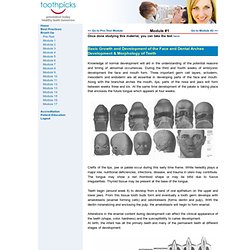
During the third and fourth weeks of embryonic development the face and mouth form. Three important germ cell layers, ectoderm, mesoderm and endoderm are all essential in developing parts of the face and mouth. Along with the branchial arches the mouth, lips, parts of the nose and jaws will form between weeks three and six. At the same time development of the palate is taking place that encloses the future tongue which appears at four weeks. Clefts of the lips, jaw or palate occur during this early time frame. Video Lectures: Sealant. Your Child's Teeth: Development Chart and Eruption Schedule. Why do I need to register or sign in for WebMD to save?

We will provide you with a dropdown of all your saved articles when you are registered and signed in. The following chart shows when your child's primary teeth (also called baby teeth or deciduous teeth) should erupt and shed. Eruption times vary from child to child. As seen from the chart, the first teeth begin to break through the gums at about 6 months of age. Usually, the first two teeth to erupt are the two bottom central incisors (the two bottom front teeth). Other primary tooth eruption facts: Continue reading below... Dental growth & development. Smile: Healthy Teeth, Healthy Body [Health Canada, 2009] Health Canada 2009 ISBN: 978-1-100-12457-5 (PDF Version) Cat.
![Smile: Healthy Teeth, Healthy Body [Health Canada, 2009]](http://cdn.pearltrees.com/s/pic/th/smile-healthy-health-canada-27948161)
No.: H14-54/2009E-PDF HC Pub.: 3310 (PDF Version) In partnership with: Canadian Dental Association, Dental Industry Association of Canada, Dentistry Canada Fund Help on accessing alternative formats, such as Portable Document Format (PDF), Microsoft Word and PowerPoint (PPT) files, can be obtained in the alternate format help section. Table of Contents Links between Oral and General Health Can the bacteria in plaque really affect your lungs?
Faculty and Staff - Office of the Registrar - University of Alberta. CAHS_OralHealth_e. Relationship of general/oral health, canada. Competencies for the New Practitioner - Doctor of Dental Medicine (DMD) Program - UBC Dentistry. This document establishes the standards for new graduates of the UBC DMD program as they enter the dental profession.
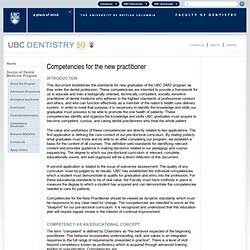
These competencies are intended to provide a framework for us to educate and train a biologically oriented, technically competent, socially sensitive practitioner of dental medicine who adheres to the highest standards of professional conduct and ethics, and who can function effectively as a member of the nation's health care delivery system. In order to meet that purpose, it is necessary to identify the knowledge and skills our graduates must possess to be able to promote the oral health of patients.
These competencies identify and organize the knowledge and skills UBC graduates must acquire to become competent, curious, and caring dental practitioners who treat the whole patient. Relationship of general/oral health, canada. Hb. Competencies For a Beginning Dental Practitioner in Canada. A competent beginning dental practitioner in Canada must be able to provide oral health care for the benefit of individual patients and communities in a culturally sensitive manner.
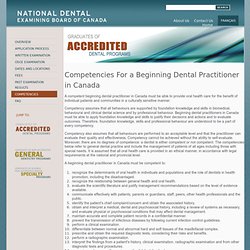
Competency assumes that all behaviours are supported by foundation knowledge and skills in biomedical, behavioural and clinical dental science and by professional behaviour. University of Manitoba: U of M - Dentistry - Accreditation. The U of M Faculty of Dentistry Doctor of Dental Medicine (DMD) program is fully accredited by the Commission on Dental Accreditation of Canada enabling all graduates to seek licensure throughout Canada & the U.s. after successful completion of a National Board Examination. From the Association of Canadian Faculties of Dentistry: A competent beginning dental practitioner in Canada must be able to provide oral health care for the benefit of individual patients and communities in a culturally sensitive manner.
Competency assumes that all behaviours are supported by foundation knowledge and skills in biomedical, behavioural and clinical dental science and by professional behaviour. Canadian Association of Public Health Dentistry. Oral Health - e-Learning. Discover the latest in dental surgical procedures, techniques and materials and clinical practices from the Oral Health e-Learning Center. Click on a webcast below and watch the top dental experts in their field operate.
Watch all webcasts for free! * Featured Webcast Impression Materials: Part IV. Dental Anatomy: Primary Dentition Review. Dentistry Online-Oral Anatomy. Dental Anatomy and Oral Surgery. Introduction to dental morphology. Oral Cavity, Oral Pharynx and Palatine Tonsil. Concise dental anatomy_and_morphology_0874141257. Chapter 4 Oral Anatomy. Dental Anatomy and Physiology (2009) - Welcome to IFDEA.